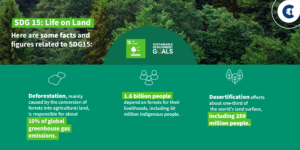
In order to meet the world’s climate goals, individuals and companies alike have to achieve significant carbon reduction. This article offers 10 simple actions you can take to reduce your carbon footprint.
As you know, carbon emissions are causing global warming and destabilizing the Earth’s climate. In order to meet the goals of the Paris Agreement and keep the temperature rise below 1.5ºC, the world needs to tackle its carbon footprint. This can be done in three steps: calculating carbon footprint (for companies, this includes categorizing emissions by scope), reducing emissions, and offsetting the remaining CO2. In this article, we focus on the second and arguably most important step: carbon reduction. Here are 10 actions both companies and individuals can take to cut their footprint.
Energy measures for carbon reduction
Energy is by far the biggest contributor to global warming, with 24.2% of greenhouse gas (GHG) emissions coming from energy use in industry and 17.5% from energy use in buildings. There are several things people and companies can do to reduce their emissions from energy use.
1. Reduce energy consumption
The first and very obvious one is to reduce energy consumption. For example, make sure you switch off all lights and equipment when leaving the house or the office. You can also reduce your air conditioning and heating use by improving isolation in your building. In industrial facilities, implementing energy efficiency measures in processes can lead to great energy and emissions savings.
2. Switch to renewable energy
Of course, we cannot function without energy, so once you have reduced your electricity consumption, you can also switch to a renewable energy provider to meet your remaining needs. Solar power is now cheaper than fossil-fuel based electricity in many parts of the world, so the switch may also bring you financial savings.
3. Buy energy-efficient equipment
Another way to reduce your energy consumption and associated carbon footprint is to invest in energy-efficient equipment, such as LED light bulbs and modern appliances.
Travel adjustments for carbon reduction
In a way, travel still belongs to the energy category, since emissions from transportation really come from the burning of fossil fuels in cars, trucks, planes and other vehicles. Overall, transportation generates 16.2% of global emissions, yet simple measures can quickly reduce this footprint.
4. Reduce number of annual flights
Aviation is the most polluting form of transportation, so the first thing to do to reduce your transportation footprint is to reduce the number of flights you take every year. On top of that, make sure you offset the emissions of the flights you do take.
5. Use public transport
Using public transportation is a sure way to reduce your carbon footprint. The average car produces 180g of CO2 per kilometer, compared to just 82g for a local bus. Even if your car is full with five people on board, each person’s individual footprint remains 36g of CO2 per km. In contrast, in a bus transporting 50 people, each person is responsible for only 1.64g of CO2 per km.
6. Walk or cycle
Another option is of course to walk or ride your bike to work: your carbon footprint will be practically zero, and you will get some exercise. At company level, it is possible to incentivize people to bike to work by making sure they have parking space or by offering flexible hours, so people can avoid peak traffic times.
7. Sustainable accommodation
Finally, when traveling for business or for fun, choose sustainable accommodation. Melia Hotels, for instance, is working hard to decarbonize its operations, and offsetting unavoidable emissions with ClimateTrade.
Food changes for carbon reduction
Agriculture, forestry and land use represent the second-largest share of global emissions, after energy. Changing our food habits is widely seen as a key step in the world’s transition to net zero.
8. Eat less meat
Producing meat, particularly beef, on an intensive scale is a highly polluting activity. Not only do large numbers of animals and their excretions emit greenhouse gases and pollute soils and water sources, but creating the space and growing the feed necessary for livestock operations often requires razing down forests. So the first and most impactful thing you can do to cut your emissions is to eat less meat.
9. Promote regenerative agriculture
Intensive agriculture is leading to soil desertification and limiting plants’ and the earth’s ability to absorb carbon emissions. In contrast, regenerative agriculture looks to maintain the soil’s natural balance and promote ecosystem health. It is even possible to implement carbon sequestration measures in the soil: that’s called carbon farming. If you can, choose products that come from regenerative farms.
10. Buy local
Finally, you can reduce the carbon footprint of your food consumption by buying local and seasonal products that haven’t had to travel very far. So head to your local market or community garden next time you need to restock your fridge!
Other recommendations to reduce your carbon footprint
Although the tips above will result in the biggest carbon reductions, there are many other things you can do to reduce your carbon emissions. In terms of waste, you should look to eliminate food waste, reuse products as much as possible and recycle. You may also want to change your purchasing habits, shopping less and from sustainable brands. In companies, it is possible to set up sustainable procurement measures through collaboration with providers. Finally, don’t forget about your digital carbon footprint: clean up your storage regularly and choose carbon-neutral electronic devices like the ones on Tu.com.
- SEO Powered Content & PR Distribution. Get Amplified Today.
- Platoblockchain. Web3 Metaverse Intelligence. Knowledge Amplified. Access Here.
- Source: https://climatetrade.com/top-10-carbon-reduction-tips-for-companies-and-individuals/
- 1
- 10
- 2%
- a
- ability
- About
- above
- Achieve
- actions
- activity
- adjustments
- After
- Agreement
- agriculture
- AIR
- Air Conditioning
- All
- and
- animals
- annual
- appliances
- article
- associated
- average
- Balance
- based
- Beef
- below
- Biggest
- board
- brands
- bring
- Building
- bus
- business
- buy
- Buying
- called
- cannot
- car
- carbon
- carbon emissions
- carbon footprint
- Carbon Reduction
- Carbon Sequestration
- cars
- categorizing
- Category
- causing
- change
- Changes
- changing
- cheaper
- Choose
- Climate
- co2
- collaboration
- come
- coming
- community
- Companies
- company
- compared
- consumption
- contrast
- contributor
- course
- Creating
- Cut
- Devices
- digital
- Dont
- down
- each
- Each person
- eat
- ecosystem
- efficiency
- electricity
- electricity consumption
- Electronic
- eliminate
- Emissions
- energy
- Energy Consumption
- energy efficiency
- energy use
- equipment
- Even
- Every
- example
- Exercise
- facilities
- Farms
- Finally
- financial
- First
- flexible
- Flights
- Focus
- food
- Footprint
- form
- fossil fuels
- from
- fuels
- full
- fun
- function
- Garden
- GAS
- generates
- get
- GHG
- Global
- global warming
- Goals
- great
- greenhouse gas
- Growing
- Hard
- head
- Health
- here
- highly
- HOURS
- House
- HTTPS
- impactful
- implement
- implementing
- important
- improving
- in
- incentivize
- includes
- individual
- individuals
- industrial
- industry
- instance
- Invest
- isolation
- IT
- Keep
- Key
- Know
- Land
- large
- lead
- leading
- leaving
- Led
- Level
- light
- local
- Look
- LOOKS
- maintain
- make
- Making
- many
- Market
- measures
- Meat
- Meet
- Modern
- most
- Natural
- necessary
- Need
- needs
- net
- next
- number
- numbers
- obvious
- offering
- Offers
- Office
- offset
- ONE
- Operations
- Option
- order
- Other
- overall
- paris
- Paris Agreement
- parking
- particularly
- parts
- Peak
- People
- person
- Planes
- plato
- Plato Data Intelligence
- PlatoData
- possible
- power
- practically
- processes
- Products
- promote
- provider
- providers
- public
- public transportation
- purchasing
- quickly
- recommendations
- reduce
- Reduced
- reducing
- reducing emissions
- regenerative
- Regenerative Agriculture
- regularly
- remaining
- remains
- Renewable
- renewable energy
- represent
- requires
- responsible
- result
- Ride
- Rise
- Savings
- Scale
- Second
- second-largest
- sequestration
- set
- several
- Share
- Shopping
- should
- significant
- Simple
- since
- So
- solar
- Solar Power
- some
- Sources
- Space
- Step
- Steps
- Still
- storage
- such
- sustainable
- Switch
- Take
- terms
- The
- the world
- their
- thing
- things
- three
- Through
- time
- times
- tips
- to
- top
- Top 10
- traffic
- transition
- transportation
- transporting
- travel
- Traveling
- Trucks
- use
- Vehicles
- Waste
- Water
- widely
- will
- without
- Work
- working
- world
- world’s
- year
- Your
- zephyrnet
- zero












